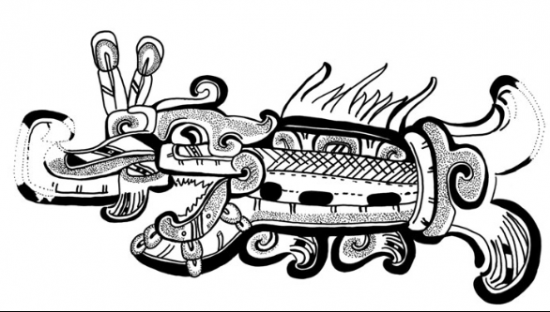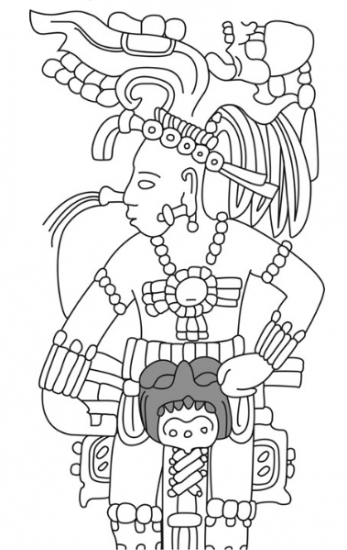 These are the kinds of shark teeth discovered in burial sites and other ceremonial remains of the inland Maya communities. From left to right, there's a fossilized megalodon tooth, great white shark tooth, and bull shark tooth. Antiquity
These are the kinds of shark teeth discovered in burial sites and other ceremonial remains of the inland Maya communities. From left to right, there's a fossilized megalodon tooth, great white shark tooth, and bull shark tooth. Antiquity
Inland Maya communities knew an awful lot about sharks without ever visiting the sea
Annalee Newitz
Source - http://arstechnica.com/science/2016/12/how-the-ancient-maya-brought-sharks-to-the-jungle/
The peoples of Classic Maya civilization were obsessed with sharks. Images of shark-like monsters appear in Maya cities throughout the regions known today as Mexico, Belize, and Guatemala—even deep in the continent's interior, where people never saw the ocean. Now one archaeologist has suggested these mythic symbols may have been based on real experiences Mayans had with sharks, as well as a brisk trade in shark jaws and giant shark tooth fossils. Shark teeth have been found in some of the earliest Maya sites in the interior, going back to 100 CE. Some are perforated, as if they were worn as jewelry. Others seem to have been attached to weapons or used in bloodletting rituals. Sea monsters with shark-like features appear on pottery and the walls of ceremonial buildings. An ancient Maya creation story features the Maize God defeating a shark in battle and sometimes being born from the creature's toothy jaws.
The question is, how did sharks become such an important part of the culture in landlocked cities? Writing in the journal Antiquity, James Madison University anthropologist Sarah E. Newman explains that coastal Maya peoples probably hunted sharks. Because sharks sink when they die, their teeth sink with them—so shark teeth among the Maya almost certainly came from the spoils of the hunt. There are accounts from Europeans who witnessed sixteenth-century Maya in the Yucatán hunting sharks using remoras, or suckerfish, to snag the great fish from their canoes. Others used massive hooks baited with chunks of meat. It's likely that traders from coastal Maya cities journeyed to the interior with shark teeth and jaws, bringing stories of the fearsome animals along with them. That said, long distance travel would have been very uncommon among people of Classic Maya civilization. Shark teeth might have been passed from trader to trader on their way inland, rather than coming directly from a person who hunted them. For inland city residents, firsthand knowledge of sharks would have been rare. Perhaps that's why they took on a special significance.
Odd symbolism explained
 This is the classic Maya logograph for the word zook, which means "shark." After Stone & Zender
This is the classic Maya logograph for the word zook, which means "shark." After Stone & Zender
In Classic Mayan writing, the logograph for shark is “xook” or “xoc,” pronounced “shok” (rhymes with “woke”). Though some linguists have suggested that the English word for shark is borrowed from Mayan languages, there is at least one example of English speakers using the word "shark" to describe these fierce fish before making contact with the Maya.
 This design was copied from an early Classic Maya piece of pottery called a tetrapod plate that stands on four legs. It shows a stylized version of a shark, emphasizing a single, central tooth. James Doyle
This design was copied from an early Classic Maya piece of pottery called a tetrapod plate that stands on four legs. It shows a stylized version of a shark, emphasizing a single, central tooth. James Doyle
There were a number of symbolic conventions among the Maya when it came to representing the xook. Often it was portrayed as having a single, large tooth, emblazoned with icons meant to convey shiny hardness. Sometimes the xook had razor-sharp teeth lining its upper jaw and practically no lower jaw at all. These creatures, explains Newman, were viewed as deities. “Classic Maya rulers associated themselves with the powerful, semi-divinity of sharks by incorporating the creatures into their names, such as Tikal’s dynastic founder, Yax Ehb Xook (“First Step Shark”) and Ix K’abal Xook (“Lady Shark Fin”), an eighth-century queen of Yaxchilan," she writes.
 Shark jaws (shaded) worn over the groin in impersonation of the Maya Maize God, as depicted on a carved slab found east of Copán’s Great Plaza. After Taube
Shark jaws (shaded) worn over the groin in impersonation of the Maya Maize God, as depicted on a carved slab found east of Copán’s Great Plaza. After Taube
Newman suggests that these divine xook images may have been more realistic than we realize. Inland sites often contain shark teeth only from the upper jaws of sharks. She suggests that these artifacts may be all that Maya from the interior knew about sharks: This correlation between iconography and artifacts raises the possibility that only the upper jaws of sharks, prized for their cutting edges, were transported inland. Indeed, it is possible that the Maya of the interior jungles never saw a complete pair of shark jaws, only the upper half. That said, there are some very realistic representations of sharks at interior sites. Possibly this can be explained by the presence of bull sharks, which are known to swim in fresh water rivers that penetrate far into the interior of Mexico and Guatemala. So it's possible that some inland Maya communities had first-hand experience with sharks, while others only saw upper jawbones.
 Found in Lamanai, Belize, this pottery vessel shows that the Maya did understand what real sharks looked like. Though stylized, this shark is recognizably anatomically correct, with nostrils and fins in the proper locations and tubes sticking out of its mouth in imitation of the barbels of a nurse shark. NMAI Photo Services
Found in Lamanai, Belize, this pottery vessel shows that the Maya did understand what real sharks looked like. Though stylized, this shark is recognizably anatomically correct, with nostrils and fins in the proper locations and tubes sticking out of its mouth in imitation of the barbels of a nurse shark. NMAI Photo Services
As for the common representation of the xook with a single tooth, Newman notes that many Maya sites contain huge fossilized teeth from Megalodon, a prehistoric shark that roamed seas that encroached on Mexico and Central America millions of years ago. It's likely that the locals excavated these teeth and imagined xook-like sea monsters with a single, huge tooth as a result. Sometimes the xook's single tooth got transplanted into other gods' mouths. Newman writes: At El Zotz, one of three versions of the Maya Sun God displays a shark tooth as his central incisor, with droplets of blood falling from his mouth. This nocturnal, blood-drinking Sun God sinks into the ‘fiery pool’ of the western sea at sunset. The sanguine droplets flowing from his mouth and the sunset-red, salty sea highlight an association between the strong saline taste of both fluids, perhaps another allusion to the Cipactli myth in which the great sea monster is speared and slain, making the ocean a realm of blood, violent conflict and dangerous beasts.
 A detail from monument 63 from the ancient Olmec site of La Venta in Tabasco, Mexico. Long before the Maya, the Olmec told a version of the creation story involving a mythical human vs. sea monster battle. Note that the sea monster's face looks like it might be modeled on the upper jaw of a shark. This theme is repeated in some Maya representations too. After Clark
A detail from monument 63 from the ancient Olmec site of La Venta in Tabasco, Mexico. Long before the Maya, the Olmec told a version of the creation story involving a mythical human vs. sea monster battle. Note that the sea monster's face looks like it might be modeled on the upper jaw of a shark. This theme is repeated in some Maya representations too. After Clark
If we assume images of single-toothed monsters were inspired by the discovery of Megalodon fossils, that would make the Maya among the first peoples on Earth to identify these Cenozoic beasts. Newman writes, "It would be almost a millennium before Europe’s burgeoning biologists would similarly tie Megalodon teeth from Malta, known as ‘tongue stones,’ to large sharks from the distant past." Beneath 1500-year-old Maya symbols lurked a scientific reality that eluded the Europeans. Perhaps xook-like sea monsters are among the earliest examples of paleontological speculation in the world.
Antiquity, 2016. DOI: 10.15184/aqy.2016.218